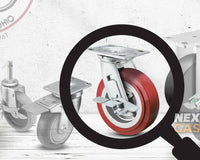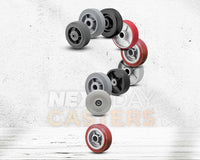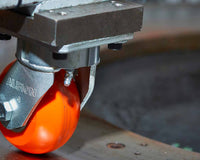NextDay Casters specializes in ANSI ICWM tested top plate casters that are available in 3" wheel to 8" wheel diameters and up to 2,800 lb. in dynamic load capacity. This article covers the basics and why it can be critical to the safety and performance of your mobile equipment and users/employees.
But why are ANSI ICWM testing standards an important thing to even mention?
Without standards, any manufacturer or seller of casters can set and publish their load ratings by any method they want. Are they publishing a dynamic load (the approved working capacity) or a static load capacity (capacity of non-moving equipment)? How did they determine the load rating? Was it just set to match the competition, or did they conduct appropriate durability testing that is designed to simulate the life expectancy of a caster (in an accelerated controlled test)?
You can see many examples of this in Amazon's caster reviews, where customers often complain of the casters not meeting the load ratings that the seller claimed they would support and sometimes damage to equipment or injuries occurring. This is why ANSI ICWM testing standards are so important. It ensures that there are controlled tests in place that a caster must pass to ensure a safe and lasting performance life. From durability testing, brake fatigue testing, and impact testing, ANSI ICWM standards are what leading US manufacturers use to safely rate and qualify the quality of their caster and wheel products. Use caution when talking to a reseller or online source who does not know how their casters were rated.
Article summary:
- ANSI ICWM testing ensures that an established (published) load rating will safely perform to the industry standards set for it, including:
- Durability (section 6.9 dynamic; shown in image below) tests to ensure the safe rolling, swiveling, and ability to withstand barriers at various speeds over 5,000 barriers (with direction changes)

- Brake fatigue (section 6.6) tests and various brake efficiency tests
- Static load test (section 6.8) and more
- All of these standards, link provided below, validate that a caster will live up to the published capacity and performance set forth by industry professionals
What is the ICWM Performance Standard for Casters and Wheels?
- As listed on the cover of their document (link below):
The ICWM Performance Standard for Casters and Wheels provides a common basis for evaluating the safety, durability, structural adequacy, and technical requirements for category specific casters and wheels (Furniture Chair Casters, Furniture Non-Chair Casters, Industrial Casters, Institutional and Medical Equipment Bed Casters). Defines industry terms, specific tests, equipment/methods that can be used, conditions of tests, and minimum acceptance levels used in evaluation. These acceptance levels are based on field and test experiences.
Where can I review the test specifications for casters?
- The standards can be viewed by visiting the interactive link on the MHI.org website: https://www.mhi.org/icwm
Why and when were these standards created?
-
As published by MHI:
In 1996, the Institute of Caster and Wheel Manufacturers (ICWM) Long Range Planning Committee identified the need to develop a complete and comprehensive North American performance standard for casters and wheels.Until this project was undertaken by the newly appointed ICWM Standards Committee (September, 1996), a comprehensive North American performance standard for casters and wheels did not exist. The ICWM Standards Committee, consisting of a cross section of the top engineers in the caster and wheel industry, met on an almost monthly basis for three and a half years to complete the work of producing the ICWM North American Performance Standard for Casters and Wheels.
The Institute of Caster and Wheel Manufacturers is an evolutionary refinement of the Caster & Floor Truck Manufacturers Association, which was founded in 1933 to educate members and users about the products of this industry and to maintain liaison with governmental agencies and other organizations. In 1950 the Association began developing standards for manual material handling products. Through the years, the Association and the Institute have developed a series of caster and wheel standards and standards for industrial trailer trucks, platform trucks, and towline trucks. ICWM cooperated with the General Service Administration, the Department of Defense, Post Office and other agencies in establishing federal and military specifications. In 1967 ICWM developed the American National Standards Institute's Industrial Caster Standard MH11.1.
Safety is important to the industry and to NextDay Casters. Please contact us with any questions, we advertise that our casters are tested to these standards to bring awareness to buyers and engineers actively buying or specifying casters. There are many caster options out there, and many do not have the appropriate testing to validate their published ratings.





